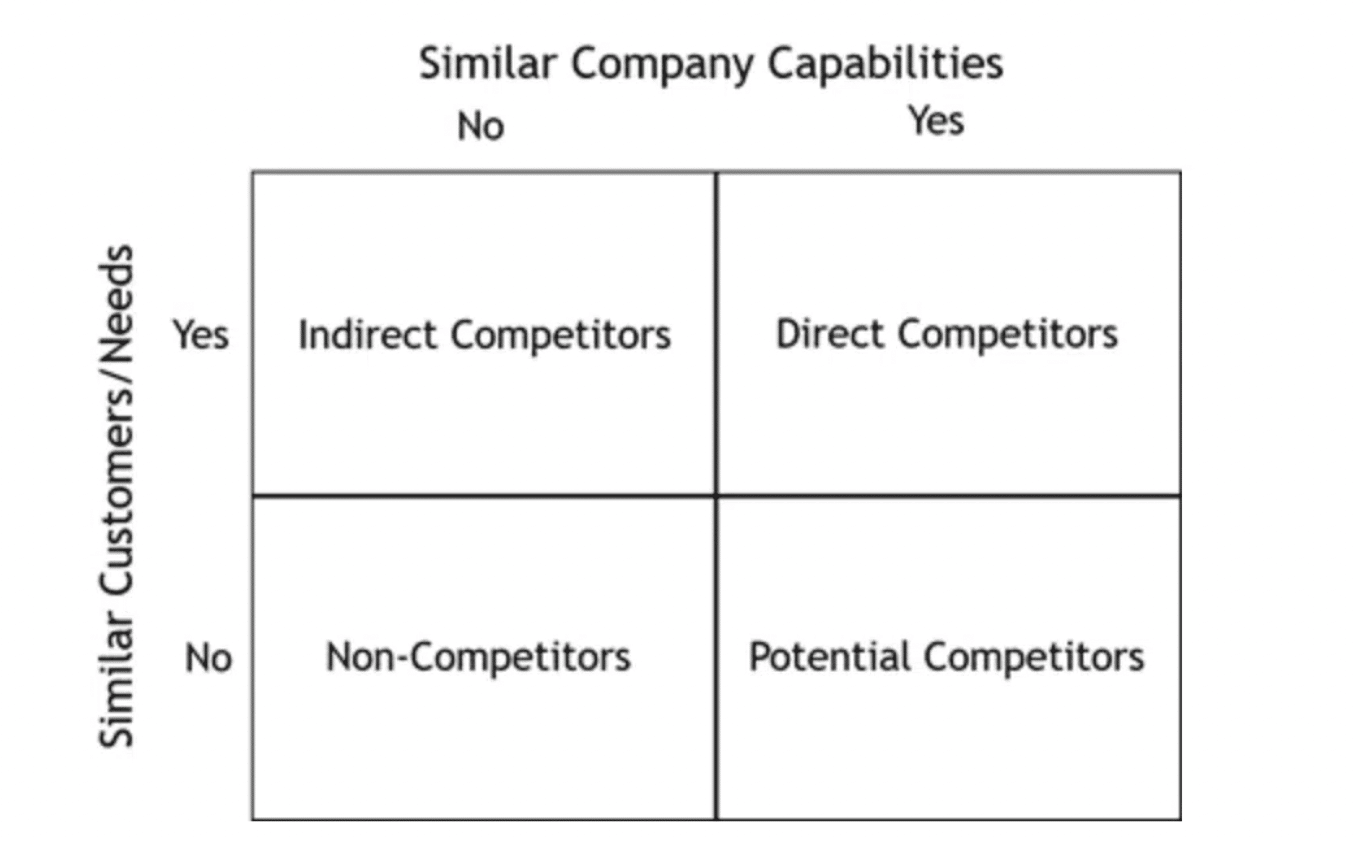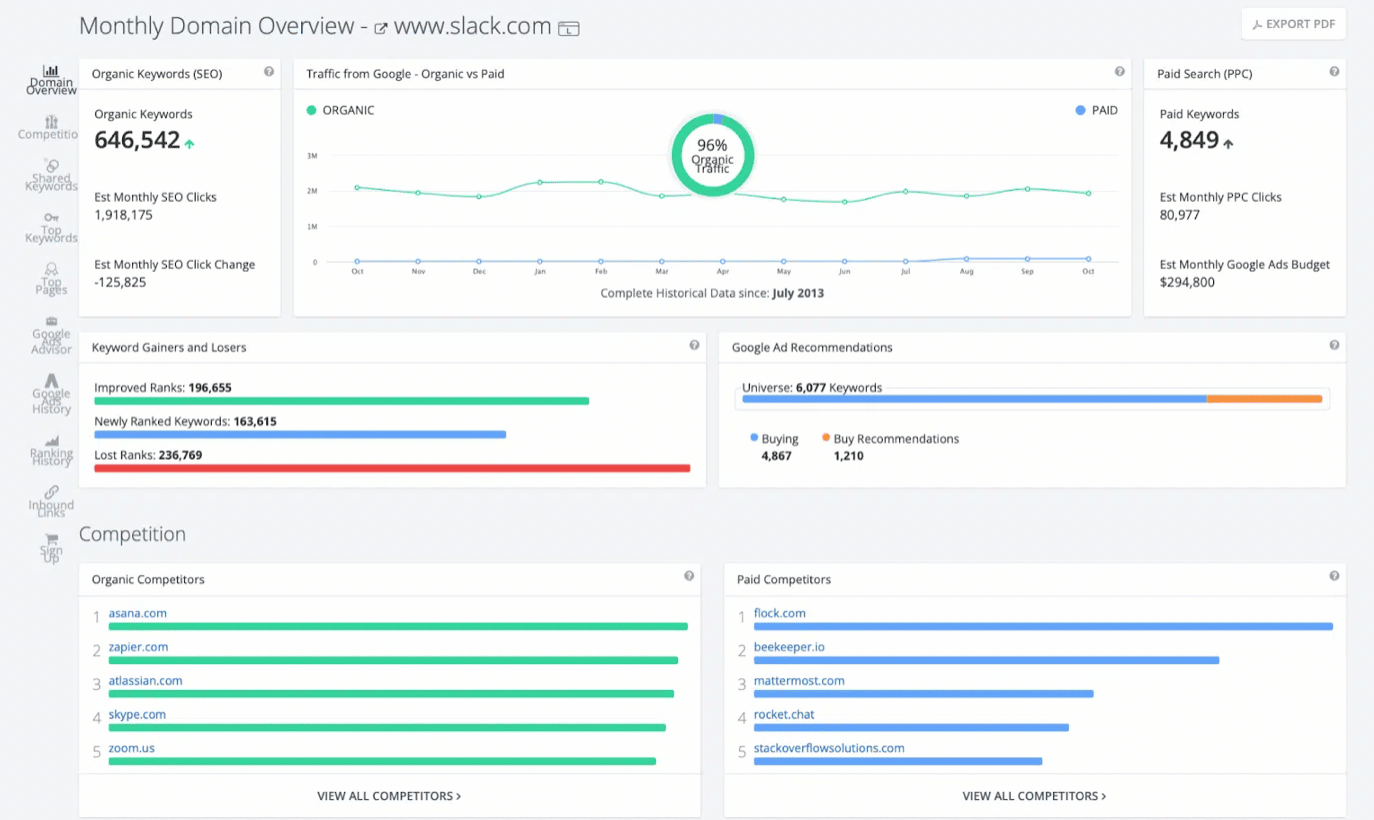5 Competitor Analysis Mistakes to Avoid at All Costs

You know that you need to track your competition carefully. You need to understand how they fit into the market and how you fit into the market, and what you can do to stand out.
That feels like a given, and it’s something most B2B and SaaS businesses understand. Many, however, struggle to implement competitive analysis properly.
There are several reasons for this. They may not have the right systems, a documented approach, or they might even be focusing on the wrong competitors altogether.
We’ve found that, in our experience, there are seven dangerous-but-common competitive analysis mistakes that are keeping brands from gaining or using competitive intelligence data effectively. In this post, we’ll take a look at each one and how to avoid them.
1. Focusing Exclusively on Direct Competitors
It’s really easy to get sucked into focusing only on known direct competitors.
You sell drag-and-drop graphic design software for $10 a month, so you look at Snappa, Canva, and Easil, which all do the same task and for a similar price point.
That’s a great start… but if you need to be looking beyond direct competitors, too.
There are a few different types of competitors you’ll want to keep track of.

Your direct competitors are going to be those that sell what you do to the same types of customers, or that are fulfilling the same customer needs. So for our graphic design software, Snappa would be a direct competitor.
Indirect competitors are those that offer similar company capabilities but go about it in a different way. Adobe’s Photoshop tools might fall under this category; you can customize existing images, but it’s an entirely different approach and likely different customers.
Potential competitors are those who may not have anything to do with your business, but they’re competing for the same SEO same. Our graphic design software writes a post about “best-featured images for blog posts” and we’re also competing with a photographer who is publishing a post for the same keyword.
Keeping track of the entire market is important because indirect and potential competitors can have direct impacts on your business. Go beyond looking at your most direct competitors when reviewing where you stand in the market for the best results.
2. Focusing on the Wrong Competitors
It’s common for brands to focus in on several core direct competitors as a central part of their competitive intelligence (CI) process. That’s a solid approach, especially if you’re trying to make sure that your brand is competitive with features offered, price points, and deals.
It’s also common, unfortunately, for brands to pick the wrong competitors to hone in on. They may actually be watching an indirect competitor, thinking it’s a direct competitor.
Payroll software that’s meant for freelancers to pay themselves a salary, for example, is not going to be a direct competitor as an enterprise-grade solution that has more complex features designed for huge companies. Even though they both are focused on the same essential task, you’re looking at two entirely different types of customers and, ultimately different needs.
These two different companies would not want to look at each other when conducting pricing research, for example.
Freelancers aren’t going to want enterprise-model pricing options, where you can do a-la-carte add-ons that rack up pricing. They don’t want to call for custom pricing, or have to go through a sales demo. They want, in many cases, flat fee options that are affordable and easy to manage.
Knowing which competitors to focus on to make sure you have the right data for the right reasons is important.
3. Lacking a Systemized Approach to Competitor Analysis
Competitive intelligence should never be sitting in front of your computer, Googling core product keywords, and seeing what pops up. You don’t want to just take notes, go over them once, and tweak your marketing messaging or your pricing.
You need a formal, documented, and systemized approach to CI. Not having one is a huge competitor analysis mistake that will render all (or most) of your research nearly pointless.
You should ideally have a competitive intelligence team, especially once your business reaches 100 employees or more. You can build a CI team from internal team members working in sales, marketing, product, and customer service departments. You’ll also want to have someone from legal go over ground rules about competitor research, too, at the beginning of the process.
It’s also important to have a documented process for competitive analysis that goes over the following:
- What methods and tools will be used to research competitors
- What data you’re collecting
- How the data should be recorded, shared, and analyzed
- How many competitors and what types of competitors you’ll be tracking
- How you plan to leverage this data once you have it
4. Looking Only At One Channel for Analysis
Want to get a really good understanding of what your competitors are up to?
You shouldn’t just look at a single source of data for your competitor analysis.
You can get a great understanding of how a single competitor is pricing their products or what features they’re focusing on by checking out their site. You might also find different content on the site that showcases who their target audience is.
Social media ads (some of which you can see through the Facebook Ad Library) can show you what features they’re proiritizing and marketing to different audiences. You can see intro offers, retargeting strategies, and more.

If you view their emails, you can get a good look into their lead nurturing sequences to see how they’re working to convert users earlier.
Looking at every channel possible is often a good choice, at least when you’re needing to get up to date information (or a big-picture view) on specific competitors.
5. Conducting Analysis Just Once
A lot of brands will conduct competitive intelligence research when they’re first launching their product. This makes sense— they need to understand how they’ll fit into the market and carve out their own niche.
You can’t stop there, however. In many cases, it’s going to be important to keep a close eye on what your competition is doing on an ongoing basis.
The market changes. Your business does not and will never exist in its own bubble. Even if you’re truly creating something new and innovative, it won’t take long for someone to swoop in and to try to replicate it and take it to the next level.
You need to regularly conduct different levels of competitor analysis. This includes keeping an eye out for any new potential competitors that are entering the space. It also means going in and getting updated information about what your direct, core competitors are up to every six months or a year at the absolute least.
The B2B and SaaS industries are hyper-competitive and they’re fast moving. You need to stay up to date or you could easily be left in the dust.
6. Not Checking In With Legal
We’ve already mentioned that when you’re first forming your competitive intelligence team it’s a good idea to consult your legal department (or an attorney).
Competitive intelligence can easily get into legally murky territory, and that’s the last thing that your business needs to deal with.
If your team member downloads a whitepaper with their employee email address and you later create a similar one (even unknowingly), for example, they could potentially try to make a copyright claim.
And do you know for sure if your CI team can sign up for a product demo from a competitor under a fake company name? Or does that open the door to legal issues?
The legal department will be your best friend here. Make sure that you check in and understand what is and is not okay, and document it clearly. Go over the list with every member of your CI time thoroughly.
7. Not Using Dedicated Competitive Analysis Tools
You absolutely can go through and conduct all of your competitor analysis manually, but that can be time consuming and sometimes faulty. It’s hard to thoroughly track down all of your top competitors if you’re struggling to find them, after all.
There are a variety of different competitive intelligence research tools on the market. These tools are many, and they’re varied, with a huge number of different capabilities.
Some tools can help you identify competitors. Others can help you see what your competitors are doing (like what keywords they’re targeting for SEO, how much they’re spending on ads, and where their backlinks are coming from). Some can show how your content or a specific channel is performing compared to specific competitors.

There are plenty of great tools. To make it easy, check out our list on competitive analysis tools here, which include all of our favorites.
Final Thoughts
There’s a lot to keep track of when you’re engaging in competitor analysis research. With the right strategies, the right tools, and the ability to avoid the most common CI mistakes, however, you’re going to be off to a great start.
Want to learn more about competitor analysis? See our guide on competitive intelligence here!


